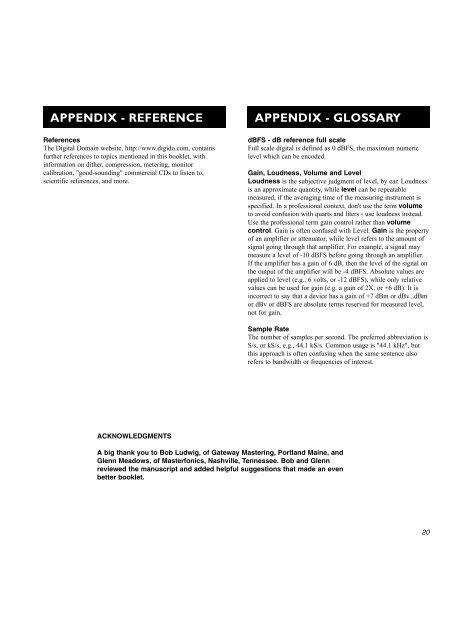2x4cdyD3b
2x4cdyD3b
2x4cdyD3b
You also want an ePaper? Increase the reach of your titles
YUMPU automatically turns print PDFs into web optimized ePapers that Google loves.
APPENDIX - REFERENCE<br />
References<br />
The Digital Domain website, http://www.digido.com, contains<br />
further references to topics mentioned in this booklet, with<br />
information on dither, compression, metering, monitor<br />
calibration, "good-sounding" commercial CDs to listen to,<br />
scientific references, and more.<br />
APPENDIX - GLOSSARY<br />
dBFS - dB reference full scale<br />
Full scale digital is defined as 0 dBFS, the maximum numeric<br />
level which can be encoded.<br />
Gain, Loudness, Volume and Level<br />
Loudness is the subjective judgment of level, by ear. Loudness<br />
is an approximate quantity, while level can be repeatable<br />
measured, if the averaging time of the measuring instrument is<br />
specified. In a professional context, don't use the term volume<br />
to avoid confusion with quarts and liters - use loudness instead.<br />
Use the professional term gain control rather than volume<br />
control. Gain is often confused with Level. Gain is the property<br />
of an amplifier or attenuator, while level refers to the amount of<br />
signal going through that amplifier. For example, a signal may<br />
measure a level of -10 dBFS before going through an amplifier.<br />
If the amplifier has a gain of 6 dB, then the level of the signal on<br />
the output of the amplifier will be -4 dBFS. Absolute values are<br />
applied to level (e.g., 6 volts, or -12 dBFS), while only relative<br />
values can be used for gain (e.g. a gain of 2X, or +6 dB). It is<br />
incorrect to say that a device has a gain of +7 dBm or dBv...dBm<br />
or dBv or dBFS are absolute terms reserved for measured level,<br />
not for gain.<br />
Sample Rate<br />
The number of samples per second. The preferred abbreviation is<br />
S/s, or kS/s, e.g., 44.1 kS/s. Common usage is "44.1 kHz", but<br />
this approach is often confusing when the same sentence also<br />
refers to bandwidth or frequencies of interest.<br />
ACKNOWLEDGMENTS<br />
A big thank you to Bob Ludwig, of Gateway Mastering, Portland Maine, and<br />
Glenn Meadows, of Masterfonics, Nashville, Tennessee. Bob and Glenn<br />
reviewed the manuscript and added helpful suggestions that made an even<br />
better booklet.<br />
20


